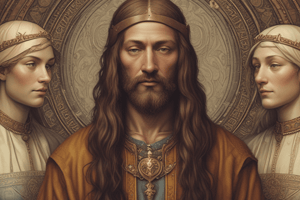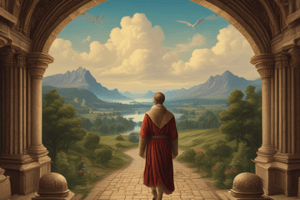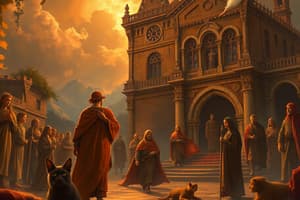Podcast
Questions and Answers
¿Cuál de los siguientes ejemplos arquitectónicos representa mejor la influencia de los elementos clásicos durante el Renacimiento?
¿Cuál de los siguientes ejemplos arquitectónicos representa mejor la influencia de los elementos clásicos durante el Renacimiento?
¿Cómo influyó el auge de las ciudades-estado italianas en el florecimiento del Renacimiento?
¿Cómo influyó el auge de las ciudades-estado italianas en el florecimiento del Renacimiento?
¿Qué efecto tuvo la invención de la imprenta en la difusión de las ideas renacentistas en Europa?
¿Qué efecto tuvo la invención de la imprenta en la difusión de las ideas renacentistas en Europa?
¿Cuál de los siguientes representa un avance científico significativo que ocurrió durante el Renacimiento?
¿Cuál de los siguientes representa un avance científico significativo que ocurrió durante el Renacimiento?
Signup and view all the answers
¿Cómo influyó la migración de eruditos griegos a Italia tras la caída de Constantinopla en el Renacimiento?
¿Cómo influyó la migración de eruditos griegos a Italia tras la caída de Constantinopla en el Renacimiento?
Signup and view all the answers
¿Cuál de las siguientes opciones describe mejor el cambio filosófico fundamental que impulsó el Renacimiento?
¿Cuál de las siguientes opciones describe mejor el cambio filosófico fundamental que impulsó el Renacimiento?
Signup and view all the answers
¿Cómo influyó el mecenazgo en el desarrollo del Renacimiento?
¿Cómo influyó el mecenazgo en el desarrollo del Renacimiento?
Signup and view all the answers
¿Cuál de las siguientes obras ejemplifica mejor el énfasis renacentista en el clasicismo?
¿Cuál de las siguientes obras ejemplifica mejor el énfasis renacentista en el clasicismo?
Signup and view all the answers
¿Cómo reflejó el trabajo de Leonardo da Vinci el ideal renacentista del 'hombre universal'?
¿Cómo reflejó el trabajo de Leonardo da Vinci el ideal renacentista del 'hombre universal'?
Signup and view all the answers
¿Cuál fue la importancia de la perspectiva en el arte renacentista?
¿Cuál fue la importancia de la perspectiva en el arte renacentista?
Signup and view all the answers
¿Cómo contrastan las ideas presentadas en El Príncipe de Nicolás Maquiavelo con los escritos políticos medievales típicos?
¿Cómo contrastan las ideas presentadas en El Príncipe de Nicolás Maquiavelo con los escritos políticos medievales típicos?
Signup and view all the answers
¿Cómo contribuyó William Shakespeare al florecimiento del humanismo renacentista?
¿Cómo contribuyó William Shakespeare al florecimiento del humanismo renacentista?
Signup and view all the answers
¿Cuál de los siguientes factores no contribuyó a la difusión de las ideas renacentistas por toda Europa?
¿Cuál de los siguientes factores no contribuyó a la difusión de las ideas renacentistas por toda Europa?
Signup and view all the answers
Flashcards
Arquitectura
Arquitectura
Incorporó elementos clásicos como columnas y arcos en edificios.
Literatura Renaissance
Literatura Renaissance
Producción de novelas y poemas que exploraron emociones humanas.
Modelo heliocéntrico
Modelo heliocéntrico
Teoría propuesta por Copérnico que coloca al Sol en el centro del sistema solar.
Humanismo
Humanismo
Signup and view all the flashcards
Imprenta
Imprenta
Signup and view all the flashcards
Renacimiento
Renacimiento
Signup and view all the flashcards
Secularismo
Secularismo
Signup and view all the flashcards
Individualismo
Individualismo
Signup and view all the flashcards
Clasicismo
Clasicismo
Signup and view all the flashcards
Mecenazgo
Mecenazgo
Signup and view all the flashcards
Leonardo da Vinci
Leonardo da Vinci
Signup and view all the flashcards
Machiavelli
Machiavelli
Signup and view all the flashcards
Study Notes
General Characteristics
- The Renaissance, meaning "rebirth" in French, was a period in European history marking a transition from the medieval period to the modern era.
- It emphasized human potential, reason, and classical learning, leading to advancements in art, science, literature, and philosophy.
- The Renaissance began in Italy during the 14th century and spread throughout Europe over the next centuries.
- It was marked by a shift from the medieval focus on religious dogma to a more humanistic and secular view of the world.
Key Features of the Renaissance
- Humanism: A philosophical and intellectual movement emphasizing human potential, achievements, and values. Humanists studied classical Greek and Roman texts, focusing on human experience and reason.
- Secularism: A shift towards less focus on religious matters and more on worldly concerns. Art, literature, and thought explored themes beyond religious doctrine.
- Individualism: Emphasis on the unique qualities and talents of individuals. Renaissance figures celebrated their accomplishments and sought personal glory.
- Classicism: A revival of interest in classical Greek and Roman art, architecture, literature, and philosophy. Renaissance artists and thinkers drew inspiration from classical forms and ideals.
- Patronage: Wealthy patrons, including the Church, played a crucial role in supporting artists, writers, and thinkers, enabling the creation of masterpieces and the spread of Renaissance ideas.
Key Figures and Works
- Leonardo da Vinci: A true Renaissance man, excelling in art, science, engineering, and more. Famous works include the Mona Lisa and The Last Supper.
- Michelangelo: Renowned sculptor, painter, architect, and poet. Created masterpieces like the Sistine Chapel ceiling and the Pietà.
- Raphael: Known for his harmonious and balanced compositions. His works, like the School of Athens, exemplify High Renaissance ideals.
- Niccolò Machiavelli: A political philosopher known for his influential work, The Prince. He explored the acquisition and maintenance of political power.
- William Shakespeare: A key figure whose works embody the culmination of Renaissance humanism and storytelling. Famous plays include Hamlet, Romeo and Juliet, and Macbeth.
Renaissance in Different Fields
- Art: Characterized by realism, perspective, and human anatomy in paintings and sculptures.
- Architecture: Incorporated classical elements like columns and arches into buildings. Examples include St. Peter's Basilica and the Palazzo Pitti.
- Literature: Produced influential novels, poems, and plays exploring human emotions and experiences. Dante Alighieri's Divine Comedy exemplifies the transition from Medieval to Renaissance narratives.
- Science: Saw advancements in astronomy, mathematics, and anatomy. Nicolaus Copernicus proposed the heliocentric model of the solar system.
- Philosophy: Humanists like Erasmus challenged Church authority and emphasized reason.
- Music: The Renaissance era saw the development of polyphonic music, using multiple simultaneous melodies.
Factors Contributing to the Renaissance
- Rediscovery of classical texts: The fall of Constantinople and the migration of Greek scholars to Italy exposed Europeans to lost texts, sparking a revival of classical learning.
- Rise of Italian city-states: The economic prosperity of these city-states provided patronage for arts and scholarship, fostering humanist thought.
- Growth of trade and commerce: Increased trade routes facilitated the exchange of ideas and goods, promoting knowledge exchange.
- The invention of the printing press: This invention was crucial for disseminating knowledge and spreading Renaissance ideas throughout Europe.
Studying That Suits You
Use AI to generate personalized quizzes and flashcards to suit your learning preferences.
Description
El Renacimiento, un período de transición de la Edad Media a la era moderna, se originó en Italia en el siglo XIV. Se caracteriza por un enfoque en el potencial humano, la razón y el aprendizaje clásico, impulsando avances en arte, ciencia y literatura. Este movimiento promovió el humanismo y el secularismo.





